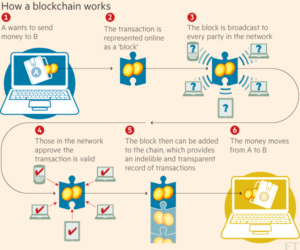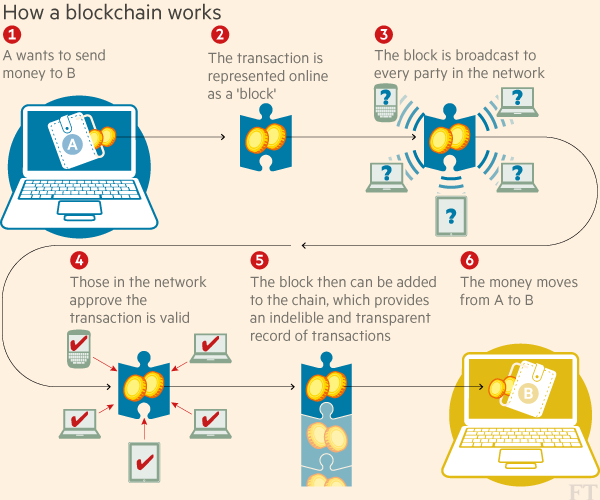There’s been much hype around blockchain technology and how it may solve a host of problems facing the online advertising and marketing industry. [caption id="attachment_737" align="alignleft" width="300"]

Source: The Financial Times[/caption]Blockchain is best known as the underlying ledger technology for Bitcoin and cryptocurriences. But it has also recently been applied to a variety of applications in healthcare and finance. And now the online marketing and advertising industries are also leveraging its potential.Because blockchain is distributed, has smart contract functionality, and a variety of security features, it's been heralded as the latest savior to serious challenges with transparency, fraud, and tracking.The verifiable “chain” or “blocks” of transactions makes it attractive for digital marketers. These blocks are continuously time-stamped and verified by a peer-to-peer network. Once added to the chain of transactions, blocks cannot be altered. That makes it a single immutable source of truth.
Transparency
There is a lot of interest in blockchain applications that bring transparency to the programmatic ecosystem. It could solve issues around reducing the fees incurred as media dollars move from a marketer and its agency through various partners in the programmatic space ( trading desks, demand-side platforms, data and targeting vendors, ad verification services, exchanges and more). These fees can add up. According to 2017 data from Warc, over $30 billion of the $63.4 billion spent on programmatic advertising worldwide wound up in the hands of tech vendors. The “tech tax” accounted for 55% of all programmatic spend, according to Warc.
Fraud
Blockchain also has a potential to eliminate the growing discrepancies between what advertisers are paying for and what they actually get. With blockchain-based transactions, media buyers can easily track the number of impressions that are being delivered and verify whether those ads were targeted to the right audiences and served in the right place and at the right time.Since all members of the blockchain network are approved and verified by other participants, bad actors and cybercriminals have no chances to get into the system. Therefore, every impression comes from an authenticated publisher with a validated domain. This minimizings such fraudulent activities as bot traffic, domain spoofing, pixel stuffing, and ad stacking. Additionally, companies can also use blockchain's smart contracts for deal IDs and private marketplaces. Smart contracts are pieces of code or distributed apps, written by developers, that set up a binding agreement triggered only by a specific external event. For example, an affiliate is only paid a commission if certain actions are taken on a retailer's website. Smart contracts are self-executing and fully self-enforcing.And, because there's the public ledger, it can't be gamed or changed. Instead, everyone from the partners to market regulators has the ability to scrutinize the transaction. In the future, a smart contract could be updated every day with the latest delivery, impression or click data, and even initiate payment when the campaign concludes.
Tracking
The idea is that blockchain technology could track where clicks come from and ensure clicks were generated by actual people and not an automated process or bot. The current tracking process is is automated via a tracking pixel. However, this process can be manipulated, hacked or abused. Additionally, since tracking information is currently stored in a central location, it can be vulnerable to hacking, human error, and equipment malfunction. When blockchain is used, these errors are impossible. The information is distributed and stored on all the computers in the network that communicate between each other.In addition, the use of smart contracts ensures all tracking is 100% accurate and fraud is avoided. This means every time someone clicks on the affiliate referral link, a smart contract is created. It has a unique id of that specific visitor, with the timestamp and the activity in question. This information would be available to both the advertiser and the publisher. And it can’t be manipulated in any way.
Privacy
All members of this peer-to-peer network can access and review information on who did what, when and how. This complete transaction history from day one is replicated all over blockchain ledgers. It is approved by all participants and secured by the latest cryptography.These levels of public security means that cybercriminals have no ability to access the data, copy it or hack it. Transaction information is secured and protected by all members of the chain. Every ledger gets a unique public key in the block, which is then distributed all over the participating nodes with links to previous and following blocks. Data leakage or data theft is impossible because blockchain networks have no single point of failure.
Limitations
Slow Validation
Blockchain’s biggest asset is decentralization. But that may also be its biggest weakness in the digital marketing space. Its distributed nature has transactions verified by “miners” around the world. But that means that blockchain can’t analyze or process real-time advertising transactions fast enough. Current confirmation times for a transaction to be validated and added to the public ledger range between 10 and 30 minutes. That doesn't match up with the millisecond response times required to return an ad. That makes blockchain too slow to be a tool for real-time fraud prevention and validation. Instead, companies are using it as a post-campaign layer to validate and authenticate transactions long after the fact. While the eventual reconciliation can prevent money from getting into the wrong hands, the lack of real-time verification is a current drawback.
Scale and Adoption
Blockchain also faces the hurdle of adoption and scale. By design, the technology needs to reach a critical mass of users before it works as intended. Adoption and scale is a solvable problem. However, it's still years away before every player in the landscape invests the time and resources necessary to commit to the technology as a transactional layer.
Blockchain Potential
Blockchain is still in its infancy. And 2018 will be a year of testing and learning. Blockchain has plenty of features that make it intuitively applicable and appealing to online marketers. Still, its limitations means that blockchain-based platforms are still years away.However, that shouldn’t prevent marketers from innovating and experimenting with blockchain. The most effective approaches to integrate this technology for marketers will consider both its potential and its limitations to produce real and sustainable innovation.











